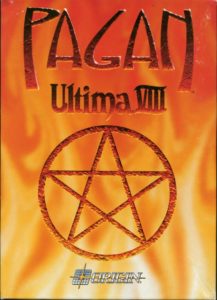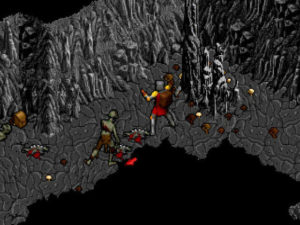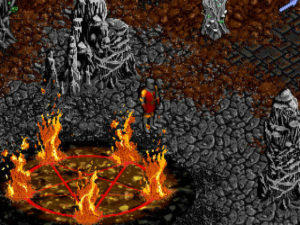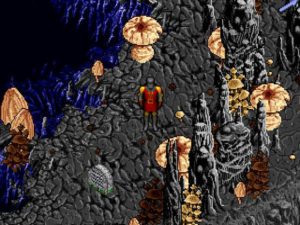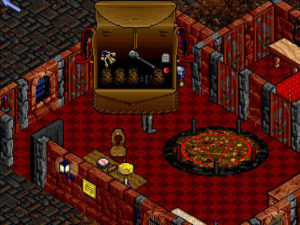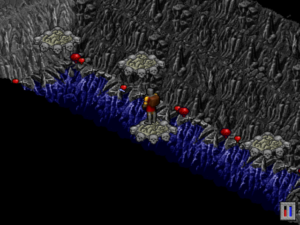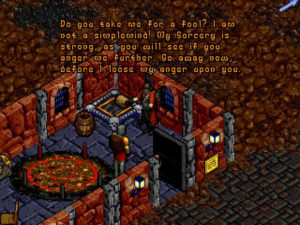In 1994, Origin Systems’s Ultima series was the most universally lauded franchise in computer gaming. Over the course of seven mainline games and five spinoffs and side stories, the Ultima brand had consistently stood for elaborate but doggedly nonlinear plots which seriously engaged with questions of ethics; for the familiar but ever-evolving and ever-welcoming world of Britannia in which most of the games took place; for a merry group of recurring boon companions with whom the Avatar, the player-defined protagonist of the games, adventured each time; for complex rules systems and knotty central mysteries that required brainpower and lots of notepaper rather than reflexes to work through.
But then, for the eighth game in the mainline Ultima series, Origin decided to try something just a little bit different. They made a game in which you played a thoughtless jerk moving on rails through a linear series of events; in which you never went to Britannia at all, but stayed instead on a miserable hellhole of a world called Pagan; in which you spent the whole game adventuring alone (after all, who would want to adventure with a jerk like you?); in which the core mechanics were jumping between pedestals like Super Mario and pounding your enemies over the head with your big old hammer.
Tens of thousands of eager Ultima fans, some of whom had been buying every installment of the series for ten years or more, rushed home from their local software stores with Ultima VIII: Pagan in their hot little hands. An hour later, they were one and all sitting there scratching their heads and asking themselves what the hell had happened. Had they bought the wrong game entirely? No, it said “Ultima” right there on the box!
For the past quarter century, Ultima fans have continued to ask themselves that same question: what the hell happened with Ultima VIII? It stands today as one of the most bizarre would-be series continuations in gaming history, such a colossal failure to meet its players’ expectations that, alone and unaided, it killed dead at a stroke the most venerable franchise in computer gaming. No, really: Origin couldn’t have shot Ultima in the head more efficiently if they’d tried. And so we ask ourselves again: what the hell happened? What the hell was Origin thinking?
In seeking to explain the seemingly unexplainable, Ultima fans have tended to hew to a simple, naturally appealing narrative that paints Electronic Arts — gaming’s very own Evil Empire — as the unmitigated villain. After acquiring Origin in late 1992, so the story goes, EA forced them to abandon all of the long-established principles of Ultima in order to reach the mass market of lowest-common-denominator players to which EA aspired. Richard Garriot — a.k.a. “Lord British,” the father of Ultima and co-founder of Origin — has embraced this explanation with gusto, part and parcel of a perhaps too prevalent tendency with His Lordship to lay his failures at the feet of others. From Garriott’s 2017 memoir:
The reality is that EA earns most of its revenue with terrific games like Madden Football. Every year they publish a new edition, which reflects the changes in the NFL. They don’t have to create much that’s new — they just tweak their football-game engine and update the rosters. The rules of football change slowly. At the deadline they wrap it up and release it. The audience is pre-sold.
Conversely, the games we were making could easily take two years or more to create. We released them when we were done. That was not EA’s way of doing business. “Richard,” they told me, “your release of games is incredibly unreliable.” They wanted us to change our development process to meet their deadlines. The game we were developing when we sold Origin was Ultima VIII; EA wanted it on the shelves in time for the following Christmas. This was the first time in my life that the realities of business became more important than the quality of a product. They were adamant: “Richard, you need to cut whatever needs to be cut to get this game done.” So I cut it; I cut it and I cut it and I cut it, and as a result I shipped the most incomplete, dumb, buggy game I’ve ever shipped. I still believe that if we had waited until it was complete, Ultima VIII would have been a great game. We would have been the first to market with a variety of features that eventually proved very popular in other games. But we didn’t wait, and that was my fault. I bowed to the outside pressure.
Most distressing was seeing the results of making those cuts on both the game and my team. The team saw past the warts, knew what we were up against, and loved the game for what it was; they appreciated the innovations in it rather than bemoaning what it could have been. But the press, as well as a number of players, didn’t like it at all. The reviews were terrible. All the money I’d been paid had no meaning. I felt awful that I had let down so many people in my effort to be loyal and learn from EA.
And a lot of people had made serious sacrifices to meet EA’s schedule. Many of our programmers had worked twelve hours a day, seven days a week for ten months. We would bring dinner in for them because we were afraid if they left, they might not come back. The last month or so we gave them every other Sunday off so, as one of them pointed out, they could see their family or do some laundry. The creative joy we’d once shared in developing a game had been replaced by the prosaic demands of running a business. It was hard to believe how much had changed; only a few years earlier our people would happily work all night and love every minute of it, and now we had become a sweatshop.
At least partially as a consequence of that disappointment, management told me, basically, that they didn’t want me making big games like Ultima anymore.
This classic passive-aggressive apology — “I felt awful that I had let down so many people in my effort to be loyal and learn from EA” doesn’t exactly ring out with contrition — isn’t even internally consistent; if the development team loved their game so much, why was Origin’s management forced to devise stratagems to keep them from going home out of the fear that they wouldn’t come back? Nevertheless, it does contain a fair amount of truth alongside its self-serving omissions; one would be foolish to deny that the EA acquisition played a major role in the Ultima VIII debacle. And yet the discussion should perhaps be framed rather differently. It might be more accurate to see Origin’s acquisition by EA and the eventual Ultima VIII as mutual symptoms rather than cause and effect, both being the result of Origin trying to negotiate trends that seemed to leave Ultima with less and less space to be what it had always been.
Let’s start by looking more closely at the timeline than Garriott deigns to do above. EA and Origin signed the acquisition contract in September of 1992, just five months after Ultima VII: The Black Gate had shipped. Ultima VIII would still have been in the early-concept phase at best at that point. When he refers to “the following Christmas” above, Garriott thus presumably means the Christmas of 1993. While this release date may have been a stated aspiration, it’s hard to believe it was a serious one; it would have marked the swiftest turnaround time between two mainline Ultima games since the first three of them in the early 1980s. As it was, Ultima VIII wouldn’t ship until March of 1994, still in a woefully unfinished state.
Yet the story of Ultima VIII is more than that of just one more game that was released before its time. Even had all of Origin’s plans for it come off perfectly, it would still have been a radical, seemingly nonsensical departure from everything Ultima had been in the past. Multiple sources confirm that it was in fact Richard Garriott himself rather than any soulless suit from EA who decided that the latest installment in Origin’s epic CRPG series ought to become a… platformer. He was inspired in this not by Super Mario Bros., as many fans would later suspect, but rather by Prince of Persia, Broderbund Software’s hugely popular, widely ported, elegantly minimalist, intensely cinematic linear action game. Prince of Persia was and is a more than worthy game in its own right, but it seems a strange choice indeed to use as inspiration for the latest Ultima. We should try to understand where the choice came from in the context of the times.
Garriott has often joked that he spent the first twelve years of his career making essentially the same game over and over — merely making said game that much bigger and better each time out. If so, then Ultima VII was the ultimate, if you will, version of that game. Today its reputation is as hallowed as that of any game of its era; it remains a perennial on lists of the best CRPGs of all time. Yet its mixed reception in 1992 rather belies its modern reputation. Many reviewers expressed a certain ennui about the series as a whole, and ordinary gamers seemed less excited by its arrival than they had been by that of Ultima IV, V, or VI. Ultima Underworld, a more action-oriented spinoff which was created by the outside studio Blue Sky Productions and published by Origin just a month before Ultima VII, collected more critical praise and, likely most frustratingly of all for the hyper-competitive Garriott, continued to outsell its supposed big brother even after the latter’s release. A survey in the March 1993 issue of Computer Gaming World magazine is particularly telling: Ultima VII is rated as the 30th favorite game of the magazine’s readers, while Ultima Underworld is in a tie for third favorite. Meanwhile Origin’s eighteen-month-old Wing Commander II, a cinematic action game of Star Wars-style space combat, still sits at number six.
Indeed, the role of Wing Commander in all of this should not be neglected. The brainchild of an enthusiastic young Englishman named Chris Roberts, the first game in that series had upon its release in 1990 surprised everyone by handily outselling that same year’s Ultima VI. The Wing Commander franchise had kept on outselling Ultima ever since, whilst being faster and easier to make on an installment-by-installment basis.This too could hardly have sat well with Garriott. The House That Ultima Built had become The Home of Wing Commander, and Chris Roberts was now more in demand for interviews than Lord British. The harsh truth was that EA had been far more excited about Wing Commander than Ultima when they decided to acquire Origin.
Taken as a whole, all of this must have seemed intensely symbolic of a changing industry. As computers got faster and came to sport higher-fidelity audiovisual capabilities, visceral action titles were taking a bigger and bigger slice of computer-game sales, as evinced not only by the success of Ultima Underworld and Wing Commander but by other big hits like id Software’s Wolfenstein 3D. Onscreen text was out of fashion, as was sprawl and complexity and most of the other traditional markers of an Ultima. Shorter, more focused games of the sort that one could pick up and play quickly were in. Origin had to keep up with the trends if they hoped to survive.
In fact, Origin was in an extremely perilous financial state just before the EA acquisition. EA’s deep pockets would allow them to keep pace with spiraling development costs for the time being. But in return, the games they made had to have enough mass-market appeal to recoup their larger budgets.
This, then, was the calculus that went into Ultima VIII, which begins to make the inexplicable at least somewhat more comprehensible. At this juncture in time, epic CRPGs were at literally their lowest ebb in the entire history of computer games. Therefore Ultima, the series that was virtually synonymous with the epic CRPG in the minds of most gamers, needed to become something else. It needed to become simpler and faster-paced, and if it could also jump on the trend toward grittier, more violent ludic aesthetics — I point again to the rise of id Software — so much the better. It may not have been a coincidence that, when Ultima VIII eventually shipped, it did so in a box sporting garish orange flames and a huge pentagram — the same general graphics style and even iconography as was seen in DOOM, id’s latest ultra-violent hit.
Of course, the flaws in the thought process that led to Ultima VIII aren’t hard to identify in retrospect. Games which lack the courage of their own convictions seldom make for good company, any more than do people of the same stripe. The insecure child of a nervous creator who feared the world of gaming was passing him by, Ultima VIII could likely never have aspired to be more than competent in a derivative sort of way.
The biggest blunder was the decision to slap the Ultima name on the thing at all, thereby raising expectations on the part of the franchise’s preexisting fan base which the game was never designed to meet. Ironically, the audience for an Ultima was every bit as “pre-sold,” as Garriott puts it above, as the audience for the latest Madden. And yet one game that fails to meet fan expectations can destroy just such a pre-sold audience really, really quickly, as Garriott was about to prove. (An analogy to the radical change in course of Ultima VIII might be a Madden installment that suddenly decided to become a cerebral stat-based game of football management and strategy instead of an exercise in fast-paced on-the-field action…) It would have been better to announce that Ultima was taking a break while Lord British tried something new. But it seems that Garriott identified so strongly with the only line of games he had ever seriously worked on that he couldn’t imagine not calling his latest one Ultima VIII.
So much for the conceptual flaws in the project. Alas, its execution would prove even more of a disaster.
Richard Garriott’s involvement in the day-to-day work of game development had been decreasing almost year by year, ever since he had first agreed to let other programmers help him with Ultima V back in 1986. The Ultima VIII project was set up in the same way that the last couple had been: Garriott provided a set of general design goals and approaches along with a plot outline, then dropped in occasionally on the Origin staff who were assigned to the project while they made it all happen. This time the role of project director fell to one Mike McShaffry, who had come to Origin in 1990 to work as a programmer on Ultima Worlds of Adventure 2: Martian Dreams, then held the same role on Ultima VII. Meanwhile the nuts-and-bolts designers of Ultima VIII became John Watson and Andrew Morris.
None of these people were incompetent; all would continue to pursue fruitful careers in the games industry after Ultima VIII was behind them. But on this occasion they found themselves in an untenable situation, given neither the time nor the support they needed to make a competent game even of the dubious type for which Garriott was asking. Ultima VIII would not employ the talents of Raymond Benson, the accomplished wordsmith who had made Ultima VII‘s script so exceptionally rich and subtle; he was now gone from the company, driven away like many of his peers by the insanely long hours Origin demanded of their employees. Rather than replacing him with another proper writer, Origin cobbled together a collection of programmers, artists, and designers to provide all of its comparatively scant text, most of them doing double duty with their other roles on the project. After all, it was now the age of multimedia action. How much did mere words really matter anymore?
As 1993 wore on, external events heaped more and more pressure on the team. Chris Roberts’s latest game Strike Commander appeared in the spring of 1993; it moved his patented Wing Commander approach into the milieu of a near-future techno-thriller. Everyone confidently expected it to become Roberts’s latest blockbuster hit, EA’s first great dividend on the price of the Origin acquisition. But instead it under-performed relative to expectations; gamers seemed nonplussed by the change in setting, and their computers struggled to meet its high system requirements. Origin would manage to score some successes on a more modest scale in 1993 with other, cheaper Wing Commander spinoffs and an Ultima VII Part Two, but their big cannon for the year had shot a dud. It was now up to Ultima VIII to put smiles on the faces of EA’s management.
For all that the EA acquisition certainly was a major factor in the story of Ultima VIII, it’s difficult to say for sure how much of the pressure Origin felt was brought directly to bear by their new corporate parent and how much was merely perceived. As we’ve seen, Richard Garriott hasn’t hesitated to chalk the failure of Ultima VIII up to EA’s interference, full stop. Yet the actual EA executives in question have vociferously denied micromanaging the project, insisting on the contrary that it was conceived, created, and finally shipped on terms dictated by no one outside of Origin. Even some Origin employees have admitted that EA handled their new charge with a fairly light touch for the first couple of years; it was only after such disappointments as Strike Commander and Ultima VIII had convinced them that adult supervision was sorely needed down in Austin that they took a more hands-on approach. In the end, then, we can say for sure only that the appalling state in which Ultima VIII was released was down to some gradation in between an earnest desire on Origin’s behalf to please their parent and a stern dictate from said parent to ship it now, or else!
It must be said as well that the reality of crunch time at Origin prior to Ultima VIII was somewhat different from the rosy picture which Garriott paints above. The bad-cop counterpart to Garriot the lunch-providing good cop was Dallas Snell, Origin’s hard-driving production manager. The company’s internal newsletters from the early 1990s are littered with complaints about the stresses of crunch time, sometimes accompanied by Snell’s strident but unconvincing attempts to defend the practice on the basis of passion, dedication, and esprit de corps. As a result, Raymond Benson was only one of a steady stream of talented people who came to Origin, stayed there a relatively brief period of time, and then moved on to other parts of the games industry or to other industries entirely, having made the perfectly sensible decision that no job is worth sacrificing one’s health and general well-being for.
Still, the crunch that produced Ultima VIII was extreme even by Origin’s usual standards, and the stress was undoubtedly compounded by the bad vibe of compromise and trend-chasing that had clung to the project from the start. It didn’t help that Mike McShaffry had never attempted to manage a software-development project of any sort before; he was completely unequipped to bring any semblance of order to all of the frantic effort, as he freely admits today:
To a lot of people on the development team, Ultima VIII unfortunately was a very negative development experience. Most of the team who were managing Ultima VIII — myself especially — you know, it was our first really big management task, and so…to say I really screwed it up doesn’t really come close, I don’t think, to the truth.
You can’t just put anybody at the helm of an oil tanker and say, “Take it through the strait!” and not expect something really horrible to happen. And Ultima’s a big ship to steer, and it was unfortunate that I never had the chance to figure out how to manage a team that large. It took me another ten years to really get better at it.
All of these factors led to Ultima VIII shipping in a state that almost defies critical description; seldom has a game so blatantly unfinished been allowed onto store shelves. The writing is so sparse and unrefined that it often seems like placeholder text, and yet still manages to leave threads dangling and plot holes yawning everywhere; the cloth map that is included in the box bears almost no relation to the world in the game itself, what with so much of the latter having gone missing in action; what’s left of the CRPG mechanics are so broken that it’s possible to max out your character in less than an hour of play; every place in the game looks the same, being all too clearly built from the same handful of pre-rendered graphics (giant mushrooms everywhere for the win!); every single chest in the game explodes, even if it doesn’t contain anything, as if the developers didn’t have time to address each one individually and so just set a global flag somewhere; your unresponsive lunk of a character drowns instantly if he falls into two feet of water. Tellingly, the one part of Ultima VII that is painstakingly preserved in Ultima VIII is its most annoying: an impossible inventory-management system that forces you to spend minutes at a time dragging around tiny overlapping icons just to find anything.
But none of that was quite enough to make the original version of Ultima VIII worthy of the adjective “unplayable.” What served for that was the absurdly broken jumping system. Super Mario Bros. and Prince of Persia had been designed for joypads and joysticks. Seeking to translate those paradigms to a moused-based computer, Origin came up with a relativistic jumping system whereby the length of your leap would be determined by the distance the cursor was from your character when you clicked the mouse, rather than opting for the more intuitive solution whereby you simply pointed at and clicked on a would-be destination to attempt to jump there. McShaffry:
I think, for us, it was such a departure from what we were used to. And honestly, a jumping mechanic like what we were trying to do… I think that we just didn’t have enough people on the team who were really hardcore platformer players. Something like Mario, where you have an intuitive feel for what works in a jumping system and what doesn’t work in a jumping system. I certainly hadn’t played a lot of those games until then, and so I honestly didn’t know what I was looking for.
Honestly, that’s a case where we should have listened a whole lot more to QA. They were platformers! They played every Nintendo console [game] out there, and they came back to us and said, “Hey, this jumping is kind of busted.”
I think sometimes in product development we’d get on the high horse and go, “It’s not busted; we know what we’re doing.” And in that case… that was a horrible mistake on our part to not listen to them. But hey, we were in our twenties; when you’re in your twenties, you think you’ve got god-like powers and you’re immortal.
In truth, jumping in Ultima VIII wasn’t “kind of busted” at all; it was completely, comprehensively busted. Figuring out where any given jump would land you was a black art, thanks to the sloppy mouse cursor and the impossibility of accurately judging depths in the game’s canted isometric view. The only way to get anywhere was to save before each jump and give it a try, then reload and adjust until you got it right. After four or five attempts, you might just manage it if you were lucky. Then you got to rinse and repeat for the next jump, out of what might be a dozen or more in all to get across a single obstacle. In order to fully appreciate the horror of all this, you have to remember that every single save or restore would have taken on the order of 30 seconds back in 1994. And now imagine trying to work through this process when some of the platforms you need to jump from and to are moving. On release day, Ultima VIII really was perilously close to being literally unplayable.
In keeping with a tradition dating back to the early 1980s, Richard Garriott, Mike McShaffry, and several other members of the development team turned up on CompuServe for an online conference with fans just a couple of weeks after the game’s release. These affairs were heavily moderated, and this prevented the outrage that was already percolating through the fan community from being expressed too aggressively. Nevertheless, the developers quickly learned that this meetup was not to be the usual love fest. Instead they got an earful from the fans:
Let me say that I have been playing Ultimas since I was charmed and amazed by Ultima IV on my Commodore 64. One of the best things about Ultimas was the rich, detailed world and intricate, lengthy storylines. I could look forward to easily over 100 hours with each new Ultima, an excellent value for the money. Ultima VIII, on the other hand, is way too short…
It seems like there were a lot of bugs in Ultima VIII…
I thought the game was a little rough around the edges, especially the jumping. Since many Ultima players don’t like the heavy arcade element, are you set on keeping Ultima a CRPG/action game?…
My favorite part of Ultima VII was the large world. I was a little disappointed when I found that the world in Ultima VIII was actually smaller. Will Ultima IX have a larger world and more puzzles that require thinking, as opposed to jumping and running?…
I note with some trepidation your interest/fascination with “action” and “digital speech.” I think that too many game companies are spending too many resources on the latest graphics, sounds, etc., and nowhere near enough on character development and story and interaction. Is the swing to action/arcade a marketing-driven decision, your personal [decision], or [down to] some other reason?…
I have noticed a trend toward a single-threaded story line. Any hopes of returning to the original roots with the Ultima IX story line?…
What I and a lot of other old Ultima fans saw disappear after Ultima VII was the great ability to interact. Like baking bread, etc., and I would like to know if you plan for this to return in Ultima IX. And will you pay more attention to the plot?…
I’m concerned about the decline in the Avatar’s principles. I spent two days trying to solve Bane and Vordion without breaking my oath…
I am disappointed about the length of Ultima VIII, as others have said. There’s too much running around, and the clues to locations are far too vague…
I’m disappointed in Ultima VIII. I’ve played every single Ultima, and I feel Ultima VIII is a serious step back from previous Ultimas. I hope you realize that it takes more than glitz and sound to make a good CRPG. Lastly, I really do hope you’ll fix more bugs. I had to reformat my whole hard drive because of Ultima VIII…
Are we ever going to get various sexes and races of Avatars to choose from again?…
If they didn’t know it before, Origin must have realized by the time this conference ended that they had a big, big problem on their hands. The subsequent fan reactions to Ultima VIII were and remain far more entertaining than the game itself; few games have inspired as many unhinged, poetically profane rants as this one. Writing in the fannish newsletter Questbusters, Charles Don Hall struggled to reconcile this awful game with the Lord British cult of personality that so much of hardcore Ultima fandom had always been: “My best guess is that Lord British had nothing at all to do with it, and turned development over to soulless drones who were capable of playing the earlier Ultimas but incapable of understanding what made them such great games.”
The glossier magazines weren’t quite sure what to do about Ultima VIII. Torn between the need to serve their readerships and Origin’s advertising dollars, they equivocated like crazy, often settling on an “it’s not the game, it’s me” approach: i.e., I didn’t much enjoy Ultima VIII, but you might.
The big exception was Computer Gaming World, the most long-lived and respected of all the journals, whose status gave it a degree of insulation from the need to chase advertisers. Scorpia, the magazine’s influential adventure-gaming columnist, ripped the game to shreds in her review. I’ll share just a few highlights here:
Pagan, the purported Ultima VIII, is unlike any other Ultima you may have played. If you were expecting characterization, rich story, role-playing — you’re expecting it from the wrong game…
The game might easily have been called, as a friend of mine put it, “Mario: The Avatar.” If the name “Ultima” wasn’t on the box, you might think you’d picked up the latest Sega or Nintendo game by mistake…
Pagan could well be subtitled “School Daze,” as a good 75 percent of it is having the Avatar prove he is worthy to belong to a particular magic organization. “You want to be a Necromancer? First, you must be tested!” “You want to be a Theurgist? First, you must be tested!” “You want to be a Sorcerer? First you must be tested!”…
The story, such as it is, can be summed up as “Homeward-Bound Avatar Wrecks World…”
[The Avatar] lies to become a Necromancer; joins the Theurgists solely to steal an item (thereby negating their spell-casting abilities); betrays a Sorcerer who trusted him (thereby becoming an accessory to murder); kills (in supposed self-defense) the Master of Sorcerers to obtain another needed item; and frees the two bound Titans, so the world is wracked by continual violent storms and lava rain…
Overall, Pagan is a disaster, and an embarrassment to Origin, Lord British, and Ultima fans everywhere. It tries to go in two directions at once, and succeeds only in tearing itself apart, failing dismally on all fronts…
Instead of giving a smattering of hints and tips for Ultima VIII, as was her wont with the games she reviewed, Scorpia published an outright walkthrough, in order to “help anyone playing it to finish quickly and move on to better things.” For the following issue, she wrote a detailed retrospective of Ultima IV, her avowed favorite game of all time, pointing out all the ways in which it was the archetypal Ultima — and, by pointed implication, all of the ways in which Ultima VIII had failed to live up to its legacy.
In that very same issue, Origin offered an unprecedented mea culpa for Ultima VIII. Having clearly decided that this installment was beyond hope, they tried to save the franchise’s future by throwing it, and to at least some extent its project leader Mike McShaffry, under the bus. Richard Garriott had, he said, “heard the cry of his fans”; he admitted that “the latest game design had moved too close to action gaming and strayed too far from the strengths of the series.” Origin would, they promised, place the rock-steady Warren Spector — the man who had helmed Ultima VI, Martian Dreams, and the two Ultima Underworld games — in charge of Ultima IX. “If,” Spector pleaded, “we can get some of our followers who were disappointed in Pagan to try Ultima IX, we don’t think they’ll be disappointed.” In the meantime, an all-but-complete Ultima VIII expansion disk was axed as part of a general desire to forget that the game had ever happened.
One man, however, could not possibly forget. Mike McShaffry says today that he “felt like persona non grata at Origin because I personally felt like I was being blamed for the mistakes.” After months of ineffectual bad feelings, he finally decided to do something about it. He took all of the Ultima VIII code home with him over the Thanksgiving weekend of 1994 and, as he puts it, “fixed the jumping myself,” replacing the weird system of relative leaps with a simple click-here-to-jump-here approach. Despite their wish to flush the whole thing down the memory hole, Origin agreed to put out a patch incorporating this change and a number of other desperately needed quality-of-life improvements.
It’s this version of Ultima VIII that you’ll find hosted on digital storefronts today. It’s definitely a vast improvement over the original, even taking into account the philosophical objection that it turns the jumping — intended to be a major part of the experience — into a triviality. Much respect to Mike McShaffry for making it; if he hadn’t done so, the game’s reputation would be even worse today. Even Scorpia took note of the patch in her column, and was prompted to soften her stance toward the game ever so slightly. (“I can’t guarantee the game will be more fun, but it will certainly be less frustrating.”)
Indeed, it’s quite common to hear today that Ultima VIII really wasn’t a bad game at all — that it was merely a bad Ultima, in departing way too radically from that series’s established traditions. Some fuel for this argument is provided by Crusader: No Remorse and Crusader: No Regret, a pair of science-fiction action games that used the engine developed for Ultima VIII, but were able to do so without the baggage which the Ultima name brought with it. Both were well-received upon their release in 1995 and 1996 respectively, and are still fondly remembered in some circles today. Some have gone so far as to claim that the engine influenced Diablo, Blizzard Entertainment’s 1997 mega-hit of a streamlined, story-light action-CRPG.
Still, to say that McShaffry’s patch makes a good game out of Ultima VIII strikes me as a leap too far (pun intended). At best, it moves it from unplayable to the lower end of mediocre: the boring environments, uninteresting and/or broken mechanics, poor and sometimes nonexistent writing, and general air of unpleasantness remain unpatched. Ultima VIII is not the misunderstood classic that a few thoroughgoing contrarians would have it be.
Ultima VIII is best studied not as an exercise in game design in the abstract but as an endlessly illustrative sign of its times, showing what happened when the changes being wrought upon the culture of computer gaming by the likes of Wolfenstein 3D and DOOM — not to mention Wing Commander! — collided head-on with one of that culture’s traditional standard bearers. In this case, the standard bearer in question would never be the same again. The Ultima IX which certain factions inside Origin were so eager to make as a way of spitting out the bad taste of Ultima VIII would keep getting pushed down in the priority queue after Wing Commander III appeared in late 1994 and finally provided the big hit which Origin had been looking for ever since the EA acquisition. With that event, Wing Commander‘s takeover of Origin was complete. It would be over two and a half years before gamers would hear the name of Ultima from Origin again.
(Sources: the books Explore Create by Richard Garriott with David Fisher and Dungeons and Dreamers by Brad King and John Borland; Computer Gaming World of March 1994, July 1994, August 1994, and May 1995; Electronic Entertainment of April 1994; Questbusters 111; PC Gamer of May/June 1994; PC Zone of June 1994; Dragon of August 1994; Origin Systems’s internal newsletter Point of Origin of December 1993, March 1994, and May 5 1995. Online sources include Sheri Graner Ray’s memories of her time at Origin Systems, “The Conquest of Origin” at The Escapist, and the Ultima Codex interviews with Mike McShaffry and Jason Ely. My huge thanks to Judith Pintar for digging up the online CompuServe conference that followed Ultima VIII‘s release. Note that I’ve heavily edited the excerpts that are included here for grammar, clarity, and brevity; feel free to download the full, unedited transcript.
Ultima VIII is available as a digital purchase at GOG.com.)
